It encapsulates the vivid allure of this unique butterfly. Whether you’re drawn to the males’ brighter orange wings or the more subdued females, this art form is an eye-catcher. Unlike the Monarch, with its web-like black lines, the Gulf Fritillary sports distinct black spots and silver-patterned undersides.
If you’re an aspiring photographer, capturing this beauty involves patience and the right light conditions, usually during early mornings or late afternoons. The frame you choose, be it matte or ornate, can accentuate or contrast the butterfly’s vibrant hues. Beyond just a visual spectacle, this framed art serves as a talking point for butterfly conservation and makes for a thoughtful gift. It’s not just an art piece; it’s an ode to nature’s delicate craftsmanship.
Key Points
- Identifying Gender – Male Gulf Fritillaries have brighter orange wings, while females have slightly duller and more brownish hues. Additionally, females often have larger and more rounded wings compared to males.
- How to Identify – Look for bright orange wings with distinct black spots and markings. The underside has a silver-spotted pattern, which is quite unique.
- Difference from a Monarch – While Monarchs are also orange, they have broader black lines creating a web-like pattern on their wings, and lack the silver spots found on the Gulf Fritillary.
- Photographing the Butterfly – If you’re looking to create your own framed art, patience is key. Using a telephoto lens allows you to maintain distance, reducing the chance of startling the butterfly. Shooting during early morning or late afternoon offers the best natural light.
- Frame Choices – The frame can accentuate the artwork. A simple, matte frame may help the colors pop, while a more ornate frame can add an air of sophistication.
- Artistic Mediums – Gulf Fritillary framed art can be done in various mediums, photographs, oil paintings, or even watercolors. The medium you choose will set the mood and overall feel of the artwork.
- Home Decor – The vivid colors of the Gulf Fritillary make it a great focal point in a room. Consider the room’s existing color scheme when selecting a piece.
- Conservation Awareness – Your interest in this art form can be a conversation starter about butterfly conservation, as these beauties are also indicators of ecosystem health.
- Gift Option – Given its aesthetic appeal and the symbolism of transformation that butterflies carry, a Gulf Fritillary framed art piece could make for a meaningful gift.
Gulf Fritillary Butterfly Quick Facts
| Topic | Information |
|---|---|
| Overview | The Gulf Fritillary is a bright orange butterfly, common in the Southern U.S., Central America, and parts of South America. |
| Life Cycle | Four stages: Egg, Larva (Caterpillar), Pupa (Chrysalis), Adult Butterfly |
| Habitat | Primarily found in open spaces like gardens, fields, and meadows. |
| Lifespan | Around 3 weeks for adults. |
| Predators | Birds and larger insects, although less susceptible due to their toxic nature. |
| Stages | 1. Egg 2. Larva 3. Pupa 4. Adult |
| Diet | Larvae feed on Passion vines; adults sip nectar from various flowers |
| Migration | Generally do not migrate long distances but do show seasonal movements |
| Conservation Status | Not endangered, but habitat loss affects them locally. |
| Unique Traits | Silver-spotted pattern on the underside of their wings; they also contain toxins from the Passion vines they consume as larvae |
1 Identifying Gender

Visual Differences
How to tell male and female Gulf Fritillaries apart, shall we? It’s a pretty cool subject because once you know what to look for, it’s kind of like having a secret code.
- Color
Male Gulf Fritillaries generally have this electric, bright orange color going on. It’s like they’re showing off, honestly. Females, on the other hand, are a bit more subdued. They have a more brownish-orange hue, a little less flashy but still beautiful. - Wing Shape
Now, another thing is the wing shape. Females usually have slightly larger and more rounded wings. Males have more tapered wings, which I guess makes them the sports cars of the butterfly world?
Behavioral Cues
Here’s another layer to it. You can also observe their behavior. This isn’t as definitive as the visual cues, but it’s another piece of the puzzle.
- Activity Level
Males are often more active, zipping around and showing off those bright colors. Females are generally a bit more chill, maybe hanging out on a flower for longer periods.
2 How to Identify
Key Features to Spot
Identifying a Gulf Fritillary is like recognizing a celebrity in a crowd of people. Once you know the key features, it’s super easy to spot them.
- Bright Orange Wings
First off, you can’t miss the bright orange wings. I mean, these guys are the epitome of flashy. It’s like they’re wearing neon signs that say, “Hey, look at me!” - Black Spots and Markings
But it’s not just about the orange. They’ve got these black spots and markings that add a whole layer of complexity. It’s like their own unique tattoo or signature style.
Unique Underbelly
Now, here’s the kicker, the underside of their wings. It’s a whole different story and it’s amazing.
- Silver-Spotted Pattern
Flip those wings over and boom, you’re looking at a silver-spotted pattern. It’s unique to the Gulf Fritillary and it’s like nature decided to go the extra mile and add some bling.
3 Difference from a Monarch
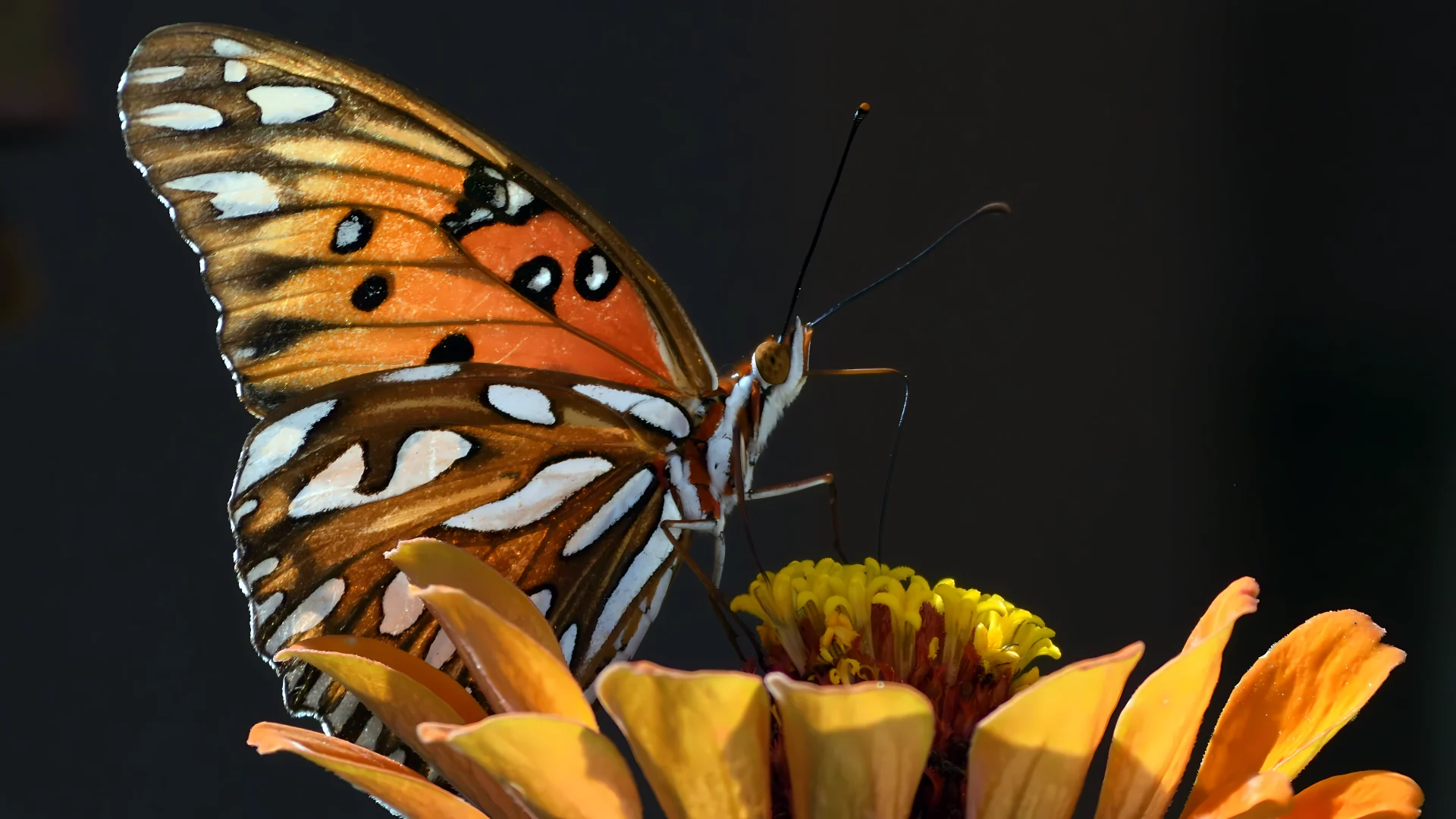
The Color Scheme
So, you’re probably wondering as I did, “Aren’t Monarchs also orange? How do I tell them apart from Gulf Fritillaries?” Great question! It’s easy to get them mixed up, but there are some dead giveaways.
- Orange But Different
Yes, both are orange, but it’s like comparing apples and oranges, pun intended. The Monarch has this richer, almost burnt orange, while the Gulf Fritillary is more of a bright, flashy orange.
The Patterns that Set Them Apart
Here’s where it gets really interesting. Each butterfly has its own style, like a fingerprint, but on their wings.
- Web-Like Pattern on Monarchs
Monarchs have these broader black lines that create a sort of web-like pattern on their wings. It’s intricate and really sets them apart. - Distinct Black Spots on Gulf Fritillaries
Gulf Fritillaries, on the other hand, have black spots and markings. It’s less of a web and more of a scattered pattern, like a Pollock painting.
The Underside Story
Now, don’t forget to check the undersides of the wings. That’s where you’ll see some more differences.
- No Silver Spots on Monarchs
Monarchs just don’t have the silver spots that Gulf Fritillaries sport on the undersides of their wings. It’s like the Gulf Fritillary went for some extra flair there.
4 Photographing the Butterfly

My Gear and Settings
So, let me tell you about the gear I used for capturing that stunning Gulf Fritillary. I went with my trusty Nikon and dialed in an aperture of f/5.6 and a quick shutter speed of 1/500. Kept the ISO low at 200 because who needs noise, right?
- Why the Telephoto Lens?
The telephoto lens was my secret weapon. It let me keep my distance, so I didn’t startle the butterfly. It’s like being a wildlife paparazzo but way less intrusive. - About Those Settings
The f/5.6 aperture and 1/500 shutter speed were a winning combo for me. Depth of field? Check. Freezing the action? Double check. And no flash needed; Mother Nature provided the spotlight.
When I Took the Shot
- Early Bird Gets the Butterfly
I chose early morning for the shoot because the light is just divine. It’s soft, it’s warm, and it doesn’t cast harsh shadows on my winged model.
The Lure of Zeina Flowers
- The Perfect Backdrop
I staked out next to some Zeina flowers. Those flowers are like the VIP lounge for butterflies. It wasn’t long before a Gulf Fritillary made an appearance. - Sun vs. Position
The sun was playing hard to get, though. One minute it was perfect, and the next it was throwing shade, literally. Had to move a few times to keep everything balanced.
Nailing the Shot
- The Moment of Truth
Finally, stars aligned, or should I say, the sun and the butterfly did. Took my shot and, voila, nailed it!
5 Frame Choices

The Impact of the Frame
Choosing the frame. Trust me, the frame can be like the backup singer to your main act; it can either make it shine or steal the spotlight.
- Why Frames Matter
You see, a frame is not just a border; it’s part of the overall visual experience. It can set the tone, mood, and even the perceived value of your artwork.
Simple vs. Ornate Frames
- The Matte Magic
If you’re going for a modern or minimalist vibe, a simple, matte frame is your best friend. Especially with a vibrant subject like a Gulf Fritillary, a matte frame lets those colors scream, “Look at me!” That’s why I picked a black frame for all the photos. - The Sophisticated Ornate
But hey, if you’re looking to jazz things up a bit, an ornate frame can work wonders. It adds a touch of elegance, a bit of old-world charm. It’s like putting a tuxedo on your butterfly.
Consider the Room
- Matching Decor
Don’t forget about the room where you’re hanging this masterpiece. A rustic wooden frame might look out of place in a sleek, modern room, and vice versa.
6 Artistic Mediums
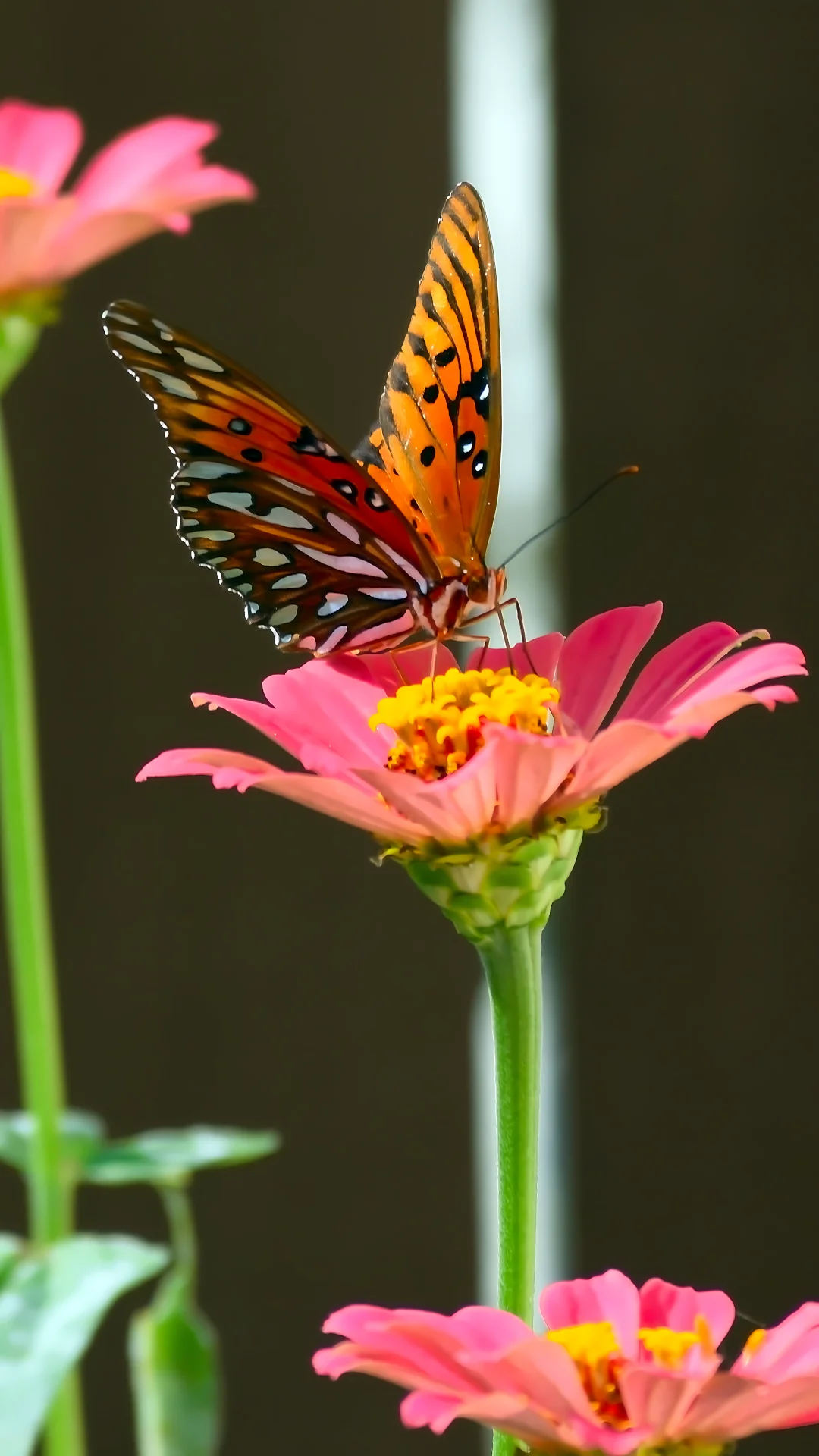
Why the Medium Matters
So let me get this straight, the medium you choose for your Gulf Fritillary artwork is like the seasoning in a dish. It’s not just about the colors or the subject; it’s about how those elements come alive. Whether it’s oils, watercolors, or photographs, each one sets a different vibe.
- Photography Is One of My Go-Tos
Having been in the photography game for over 30 years, starting with wedding gigs on an old-school Nikon film camera, this medium speaks to me. It’s direct, it’s raw, and it captures a slice of time like no other. - Oils and Watercolors
Now, if we’re talking oils, think richness and texture. Watercolors? That’s where you get that soft, almost dreamlike quality. Each has its own charm, but for me, nothing beats the immediacy of a photograph.
How Photography Captures My Passion
Switching gears from wedding photography to nature was like coming home. I love capturing couples’ big days, don’t get me wrong, but being out in nature, camera in hand, that’s where my heart is. And when it comes to subjects, the Gulf Fritillary is like the supermodel of the insect world. Fast, vibrant, and a little elusive.
7 Home Decor
Why Gulf Fritillary Art Rocks in Home Decor
The eye-popping Gulf Fritillary art piece can be the star of any room. But you’ve got to give it the right stage, so to speak. The room’s existing decor plays a big role here.
- Vivid Colors as a Focal Point
The blazing orange and intricate black patterns of the Gulf Fritillary are show-stoppers. Hang that baby on a wall, and boom, it’s like an instant conversation starter. - Why the Room’s Palette Matters
But here’s the thing, you don’t want that masterpiece to clash with your room’s existing color scheme. If your room is filled with cool tones, a hot orange butterfly might look out of place. But put it in a room with warm, complementary colors, and you’re golden.
How I Choose the Right Spot
Whenever I add a new Gulf Fritillary art piece to my space, I think about where it’s going to have the most impact. Do I want it to be the first thing people see when they walk in? Or maybe I want it in a cozy reading corner where I can admire it in peace.
- Color Coordination
Matching or complementing the room’s existing color scheme is high on my list. I mean, you wouldn’t wear stripes with polka dots, right? Same principle. - The Room’s Vibe
Also, consider the vibe of the room. Is it casual? Formal? Artsy? You want your Gulf Fritillary art to fit the room’s personality, not fight against it.
8 Conservation Awareness
Why Your Art Isn’t Just Art
So here’s a thought, your Gulf Fritillary framed art isn’t just a pretty face on your wall. It can be a real icebreaker when it comes to talking about butterfly conservation. You see, these stunning creatures are more than just winged beauties; they’re like the canaries in the coal mine for ecosystems.
- Conversation Starter
Imagine this: someone walks into your living room, spots that vivid Gulf Fritillary art piece, and goes, “Wow, that’s stunning!” Boom, you’ve got an opening to talk about why these butterflies matter. - Why Butterflies Are Important
They’re indicators of a healthy environment. If you see a bunch of Gulf Fritillaries fluttering around, chances are, the ecosystem is doing alright. And who doesn’t love good news like that?
How I Use My Art for Awareness
Whenever someone compliments my Gulf Fritillary photography, I take that as my cue. I share a bit about how these creatures are indicators of ecosystem health and how their dwindling numbers might be a red flag we shouldn’t ignore.
- Personal Connection
Having a piece of art that you’re passionate about makes these conversations natural and heartfelt. It’s not like you’re giving a lecture; you’re sharing something that genuinely matters to you. - Spreading the Word
And you know what? People listen. Maybe they’ll think twice before spraying pesticides in their gardens or become more conscious about preserving natural habitats.
9 Gift Option
Why Gulf Fritillary Art Makes a Killer Gift
So, let’s talk gifts. You know, it’s one thing to buy someone a scented candle, but giving a Gulf Fritillary framed art piece? That’s next-level gifting right there. It’s not just eye candy; it’s a bundle of symbolism and beauty all wrapped up in one.
- Aesthetics and Beyond
First off, who wouldn’t want something so stunning on their wall? The vivid colors and intricate patterns are like a constant feast for the eyes. - Symbolism of Transformation
Butterflies aren’t just pretty; they’re like the poster kids for transformation. From caterpillar to chrysalis to full-blown winged wonder, they’re a living metaphor for change and growth.
How I Choose Gulf Fritillary Art as a Gift
When I’m picking out a Gulf Fritillary art piece as a gift, it’s not just a random choice. I think about the person I’m giving it to, their taste, their home decor, and maybe even what they’re going through in life.
- Matching the Recipient
I consider their personality and what they’d appreciate. Are they more of a minimalist who’d love a simple, matte frame? Or do they dig the finer things in life and would appreciate a more ornate setting? - Timing and Occasion
Also, timing is everything. A butterfly symbolizing transformation could be perfect for someone hitting a milestone, like a graduation or a big move.
Gulf Fritillary Butterfly Photos
Click on an image to enlarge. Photos taken by professional photographer Ed Shears September 9th, 2023. All photos are copyrighted and are the property of Artabys. Contact support@artabys.com for use. Visit Shop.Artabys.com to purchase prints.

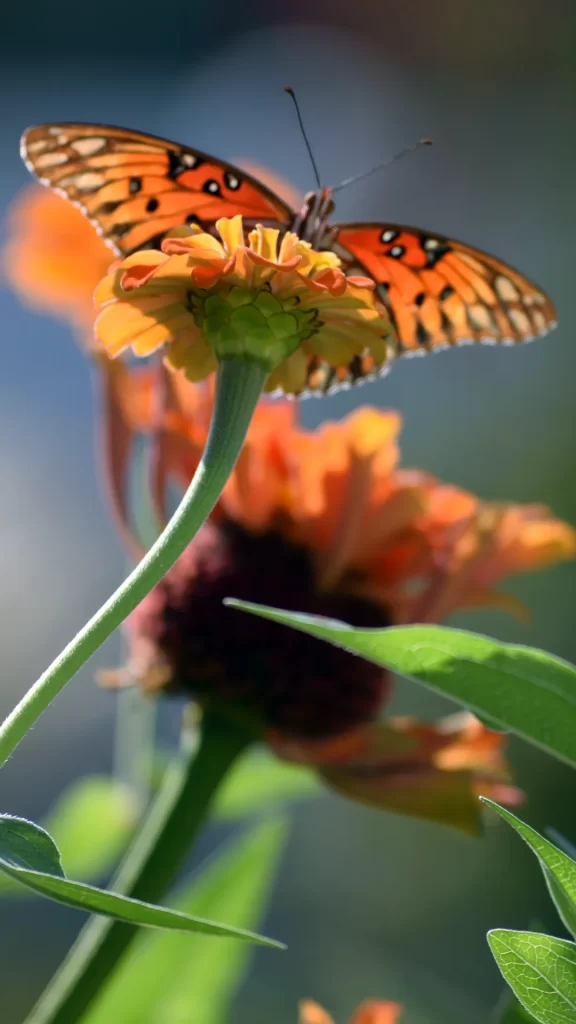
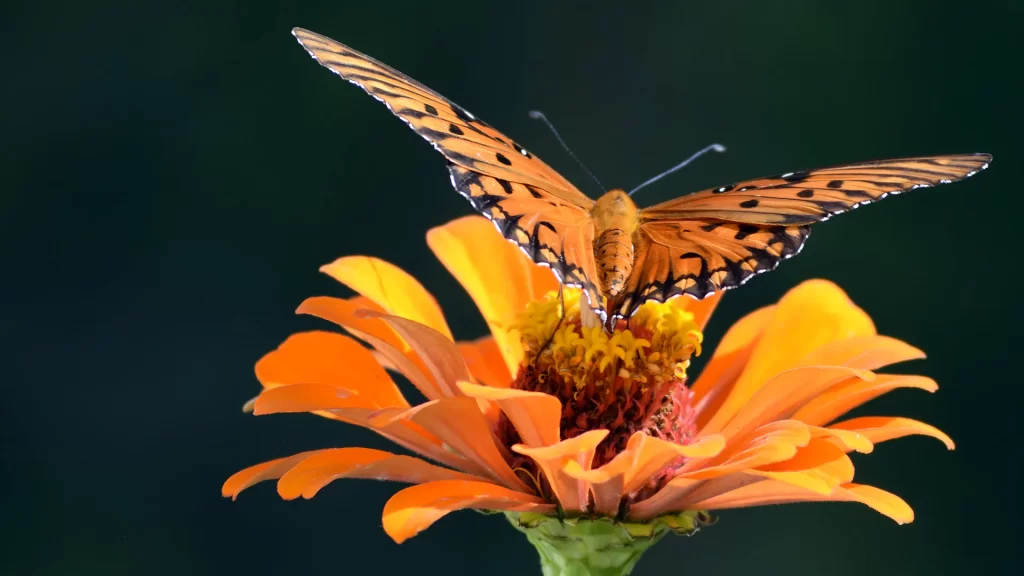
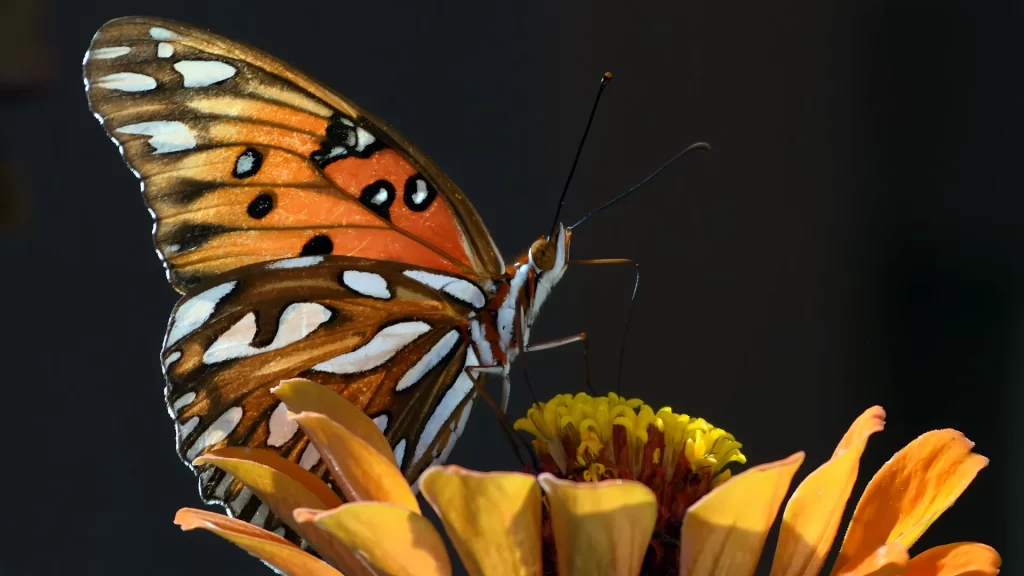

FAQ: Gulf Fritillary Framed Art
What is Gulf Fritillary framed art?
Gulf Fritillary framed art refers to visual artworks that feature the Gulf Fritillary butterfly as the main subject. These artworks are framed and suitable for display. They can be photographs, paintings, or even illustrations.
How can I tell if the Gulf Fritillary in the art piece is male or female?
Males generally have brighter, more vivid orange wings while females have a more subdued, brownish-orange hue. Also, the females often have slightly larger and more rounded wings.
What are the differences between Gulf Fritillary and Monarch butterflies in art?
In art, Gulf Fritillaries are depicted with bright orange wings with distinct black spots. Monarchs have a deeper orange hue with broad, web-like black lines. Gulf Fritillaries also often display their unique silver-spotted undersides, which Monarchs lack.
What are the best conditions for photographing a Gulf Fritillary for my own art piece?
Early morning or late afternoon offers the best natural light. Using a telephoto lens can help maintain a distance to avoid startling the butterfly. A fast shutter speed is recommended to capture the quick movements of the butterfly.
What types of frames work best for Gulf Fritillary art?
Simple, matte frames can make the vivid colors pop, while more ornate frames add an air of sophistication. The choice largely depends on your personal style and where you plan to display the artwork.
Are Gulf Fritillaries rare?
They are not particularly rare but are more commonly found in certain geographic locations, especially in the Southern United States.
How long does it take for a gulf fritillary to make a chrysalis?
It generally takes about 9–14 days for a Gulf Fritillary caterpillar to form a chrysalis, although this can vary based on environmental factors.
What artistic mediums are commonly used for Gulf Fritillary art?
Common mediums include photography, oil paintings, and watercolors. Each medium offers a different mood and texture to the artwork.
How do I incorporate Gulf Fritillary art into my home decor?
Consider the existing color scheme and style of the room. The vivid colors of the Gulf Fritillary make it a great focal point, especially in rooms with complementary or neutral tones.
Can Gulf Fritillary art be considered a conservation conversation starter?
Absolutely! These butterflies are indicators of a healthy ecosystem, and having their art can lead to meaningful discussions about conservation.
Is Gulf Fritillary framed art a good gift option? For what occasions is it suitable?
Yes, it makes a wonderful gift, particularly for occasions like birthdays, anniversaries, or housewarmings. The butterfly’s symbolism of transformation also makes it apt for milestones like graduations.
How do I care for and maintain my Gulf Fritillary framed art?
Keep it out of direct sunlight to prevent fading, and dust it lightly as needed. For oil paintings, it’s best to consult a professional for cleaning.
Where can I purchase or commission Gulf Fritillary framed art?
Art galleries, online art stores Like Artabys.com https://shop.artabys.com/product/gulf-fritillary-butterfly-framed-art-dsc_0020-framed-poster/, and specialized wildlife art shops are good places to start. You can also commission pieces from artists who specialize in nature art.
What are the price ranges for Gulf Fritillary framed art?
Prices can vary widely depending on the medium, artist, and size of the piece. Expect to pay anywhere from $50 for simpler pieces to several thousand for larger, more intricate works by renowned artists.
How can I verify the authenticity of a Gulf Fritillary art piece?
Check for signatures, certificates of authenticity, or consult with the seller or artist directly. Or buy from Artabys.com https://shop.artabys.com/product/gulf-fritillary-butterfly-framed-art-dsc_0020-framed-poster/ Ed Shears is a professional photographer and artist for over 30 years.
What is the symbolism behind choosing a Gulf Fritillary for art?
The Gulf Fritillary butterfly is often seen as a symbol of transformation and change, making it a meaningful subject in art. Its vivid colors and intricate patterns also symbolize natural beauty and complexity.
References





